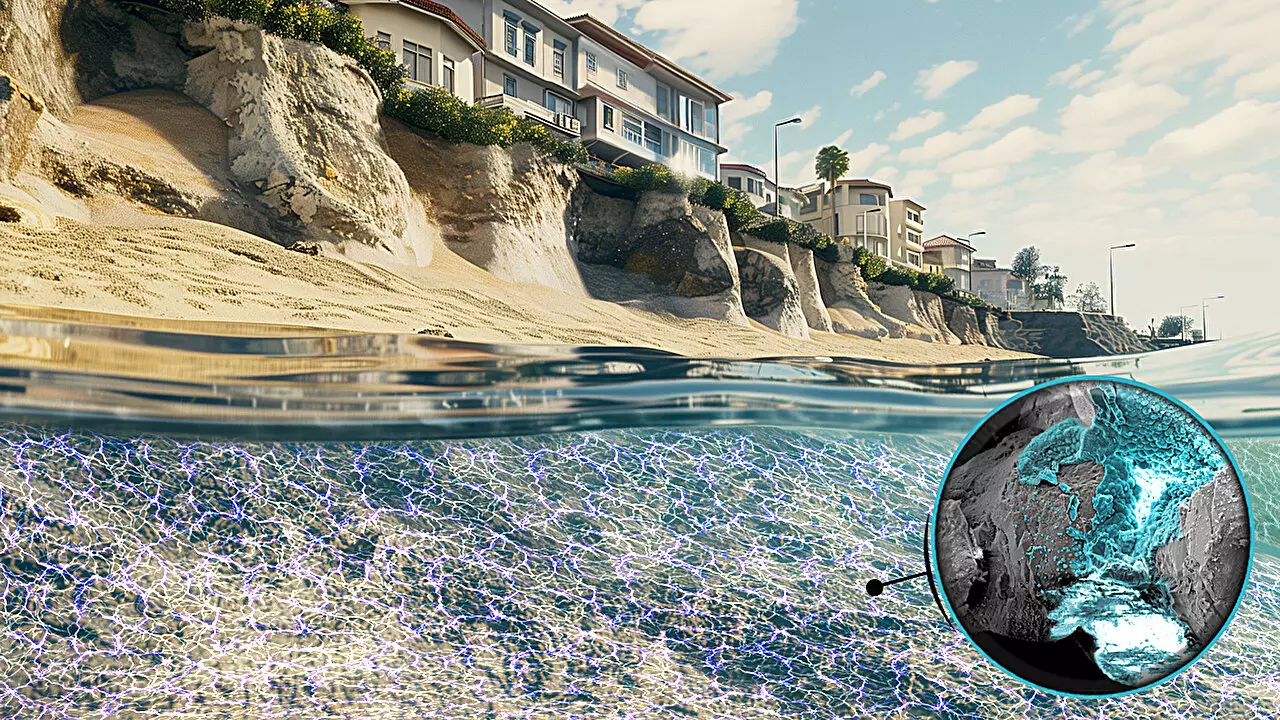Coastal erosion represents one of the most pressing challenges faced by communities worldwide, particularly in light of climate change and rising sea levels. This phenomenon not only threatens the natural landscapes of coastlines but also the infrastructures and economies dependent on them. Against this backdrop, groundbreaking research from Northwestern University introduces a novel method, harnessing electrical currents to fortify marine substrates, effectively circumventing the traditional and costly measures currently in use.
The innovative approach comes from observing natural organisms like clams and mussels, who ingeniously utilize dissolved minerals found in seawater to construct their shells. In this study, researchers sought to emulate this biological process by using a mild electrical stimulation to trigger chemical reactions in marine sands, turning them into a solidified form resembling rock. This method contrasts markedly with existing practices—solutions that often rely on building extensive protective structures or introducing cement into marine environments, both of which carry substantial financial and environmental burdens.
As Alessandro Rotta Loria, the study’s lead researcher, emphasizes, existing erosion-control methods are not only expensive but increasingly ineffective. Sea walls, for instance, suffer from their own erosive processes, requiring ongoing repairs and maintenance. With estimates suggesting that nearly 26% of the Earth’s beaches could vanish by the end of this century due to climate change, this research holds the potential for a much more sustainable alternative.
The scientific underpinning of this approach lies in the processes triggered by applying a mild electrical current (between 2 to 4 volts) to marine sands saturated with seawater. This stimulation catalyzes chemical reactions that precipitate solid minerals like calcium carbonate, the same substance used by native marine organisms for shell formation. Experiments have shown that different levels of voltage can produce various solidified compounds, effectively binding sand particles together to create an immoveable substrate.
Laboratory results demonstrate that treating varieties of sand—from silica to iron sands—transforms them into a durable, rock-like material, proving that this method has broad applicability across different coastal environments. Notably, instead of requiring extensive infrastructure investment, this approach merely replicates natural processes, thus offering a remarkable, low-cost solution that is estimated to be between $3 to $6 per cubic meter, significantly lower than traditional methods costing upwards of $70.
One of the most significant advantages of this method is its sustainability—both economically and ecologically. Unlike traditional cementation techniques that often disrupt local ecosystems, the use of weak electrical currents has been demonstrated to be non-intrusive. The short durations of electrical application minimize ecological harm, with no adverse effects observed on marine fauna during trials.
Moreover, if communities decide to reverse the process at any future point, this method allows for such interventions simply by switching the polarity of the electrodes used. This remarkable feature makes it clear that the researchers have taken into account the potential concerns regarding environmental impacts, providing a flexible and responsible mechanism for future coastal management.
The work of Rotta Loria and his colleagues goes beyond mere lab experiments; they are on the verge of testing this technique in real-world beach environments. With multiple applications envisioned—from reinforcing sea walls to stabilizing sand dunes—the research team is optimistic about the practical benefits this technology can offer to endangered coastal zones worldwide.
As coastal communities face increasing pressure from climate change, this innovative strategy presents a timely solution. By allowing sand to function as a natural cement, not only can we mitigate the effects of erosion, but we can also preserve vital coastlines for future generations.
The electrical cementation process developed by the team at Northwestern University stands as a pioneering approach to solving the complex issue of coastal erosion. By leveraging natural processes through mild electrical stimulation, this method provides a sustainable, cost-effective alternative to traditional measures. As researchers prepare for field testing, it is clear that this innovation may hold the key to protecting coastal areas from the compounding impacts of climate change for years to come. The marriage of technology with nature’s ingenuity promises a brighter future for threatened coastlines globally.


Leave a Reply